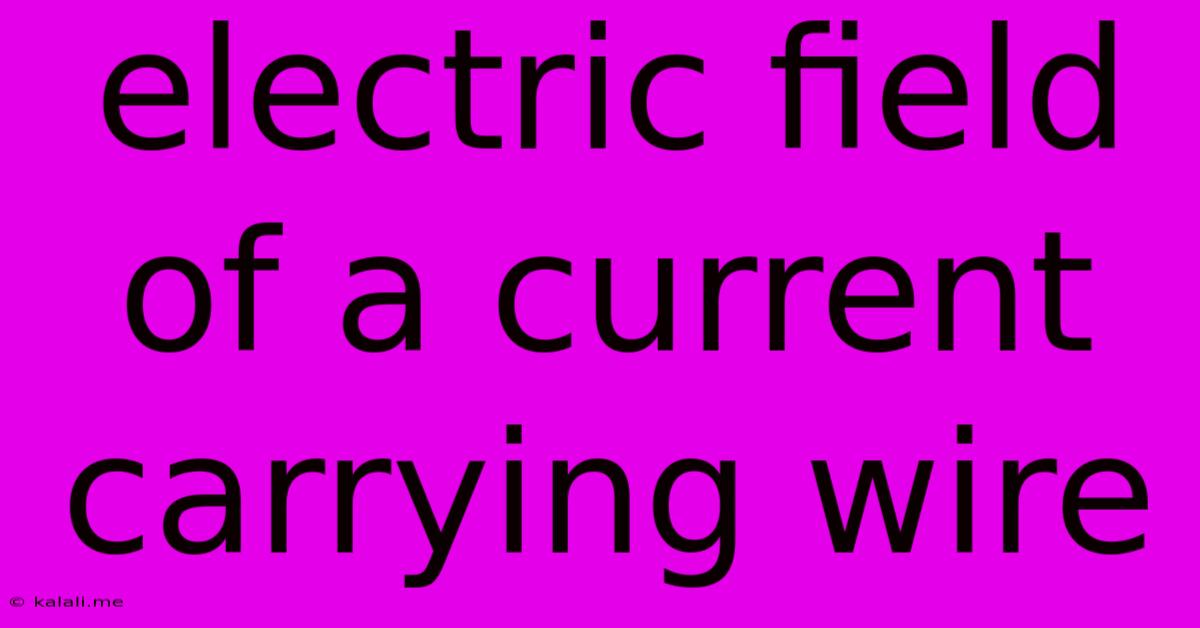Electric Field Of A Current Carrying Wire
Kalali
Jun 05, 2025 · 3 min read

Table of Contents
Understanding the Electric Field of a Current-Carrying Wire
The electric field surrounding a current-carrying wire might seem straightforward, but a deeper understanding reveals fascinating nuances. This article delves into the intricacies of this field, exploring both the static and dynamic aspects, and clarifying common misconceptions. This will cover the concepts of electric potential, magnetic fields, and their interconnectedness in the context of current flow.
What creates the electric field? The presence of an electric field around a current-carrying wire is fundamentally linked to the charge carriers (typically electrons) moving within the wire. While the wire itself is electrically neutral overall (equal number of positive and negative charges), the motion of the electrons generates the field. This isn't simply a static electric field like that produced by a charged sphere; it's a more complex phenomenon.
The Static Electric Field (a closer look)
Before considering the current, let's briefly address the static case. A neutral wire, with electrons uniformly distributed, exhibits no net external electric field. The electric fields of individual charges cancel out. This is the crucial baseline to understand the dynamic situation.
The Dynamic Electric Field (the current's influence)
When a current flows, electrons drift along the wire. This drift creates two primary effects that contribute to the overall electric field:
-
The Electric Field Due to Charge Accumulation: If the wire isn't a perfect conductor, there will be a slight resistance to the electron flow. This resistance causes a slight accumulation of negative charge at one end of the wire and a corresponding positive charge at the other. This charge imbalance generates a relatively weak, static electric field along the length of the wire, driving the current. The magnitude of this field is directly proportional to the resistance and the current.
-
The Magnetic Field and its Indirect Electric Field Effect: The moving charges (current) generate a magnetic field around the wire, described by Ampere's Law. This magnetic field, in turn, indirectly affects the electric field, especially in situations where the current is changing. For instance, a time-varying current induces an electromotive force (EMF) which leads to an electric field as described by Faraday's Law of Induction. This induced electric field is crucial in understanding phenomena like electromagnetic waves.
Common Misconceptions
It's important to address common misunderstandings:
-
The Electric Field Isn't Just Along the Wire: While the strongest component of the electric field might be along the wire due to charge accumulation, the magnetic field's influence extends radially outwards. Changes in the magnetic field can induce electric fields in surrounding space, exhibiting a more complex three-dimensional pattern.
-
The Field Isn't Simply Proportional to Current: The relationship between the electric field and the current is more nuanced, especially when considering transient effects or non-uniform current distributions within the wire. The influence of inductance and capacitance of the wire also plays a significant role in more advanced analysis.
Calculating the Electric Field (Simplified Approach)
For a long, straight wire carrying a steady current, a simplified approach focuses on the electric field resulting from the slight charge accumulation due to resistance. This field is primarily along the wire and is relatively weak compared to the magnetic field produced by the same current. Accurate calculation requires considering the material properties of the wire and the precise current distribution.
Conclusion
The electric field of a current-carrying wire is a multifaceted phenomenon, not solely defined by the current itself. The interplay between charge accumulation, resistance, the generated magnetic field, and the effects of changing currents contributes to its complexity. While simplified models offer useful approximations, a complete understanding necessitates a deeper dive into electromagnetic theory and the principles of electromagnetism at play. Further research into Maxwell's equations provides a more thorough understanding of the intricate relationship between electric and magnetic fields in this context.
Latest Posts
Latest Posts
-
Divide By 3 Circuit Using D Flip Flop
Jun 06, 2025
-
Does Internet Matter For Fps In Minecraft
Jun 06, 2025
-
Should I Pat Dry A Steak After Salting
Jun 06, 2025
-
Please Keep Us Informed Other Words
Jun 06, 2025
-
Hot Water Only Last 15 Minutes
Jun 06, 2025
Related Post
Thank you for visiting our website which covers about Electric Field Of A Current Carrying Wire . We hope the information provided has been useful to you. Feel free to contact us if you have any questions or need further assistance. See you next time and don't miss to bookmark.